Attitude DefinitionHow a person perceives and assesses something or someone is known as their attitude. It is also known as their propensity to react favorably or unfavorably to a certain concept, item, person, or circumstance. It is sometimes divided into three categories: cognitive (perceptions and beliefs), behavioral (actions taken or stated intentions toward an object based on cognitive and affective reactions), and emotional (likes and dislikes, sensations, or provoked emotions). Attitude- Meaning and DefinitionA person's attitude includes their behavior, temperament, emotion, and posture toward someone and their propensity or direction, particularly in their thoughts. "Attitude is a mental and neurological state of readiness, structured by experience, having a directive or dynamic impact upon the individual's behavior to all events and circumstances associated with it," says Gordon Allport. According to Frank Freeman, an attitude is a dispositional willingness to respond to specific institutions, people, or objects that have been learnt and evolved into one's typical mode of response. 
According to Thurstone, "Attitude refers to the sum of a man's inclinations and sentiments, prejudice or bias, preconceived concepts, thoughts, fears, dangers, and other any particular issue". The definition of attitude is "a learned propensity to behave in a consistent positive or negative manner for a particular item." ? Icek Ajzen and Martin Fishbein. "A reasonably persistent structure of thoughts about a thing or circumstance that makes someone more likely to react in a particular way is called an attitude".- Milton Rokeach. Nature of Attitude
Characteristics of Attitude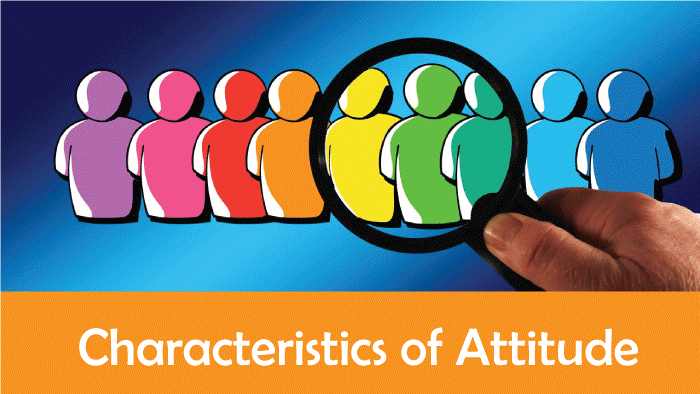
Attitude can be characterized by : Affective Cognitive Consistency: The consistency between the affective and cognitive elements affects the link between attitudes and behaviours. In other words, the stronger the relationship between attitude and conduct, the more consistency there is between cognition and evaluation. Strength: Beliefs derived from first-hand experience with the object may be maintained with more conviction. Whether emotion or cognition contributed to the development of the attitude has an impact on certainty as well. More certainty is seen in attitudes established on the basis of emotion than on the basis of intellect. Valence: This term describes the level or grade of similarity or dissimilarity towards the entity or experience. A person has a low valence attitude if they are generally uninterested in the item. Direct Experience: An attitude is a summary of a person's prior experiences; as a result, an attitude that is based on direct experience is more reliable in predicting future behavior. Direct experience also makes additional knowledge available about the object itself. Multiplicity: This term refers to how many characteristics go into forming an attitude. For instance, one person may express a desire to become a doctor, while another does so while also working hard, being real, and being serious. Relation to Needs: Attitudes fluctuate depending on the needs they address. Individuals' opinions about movies fulfil their enjoyment requirements, but employees' attitudes toward their jobs may strongly support their needs for security, success, accomplishment, and happiness. Components of Attitude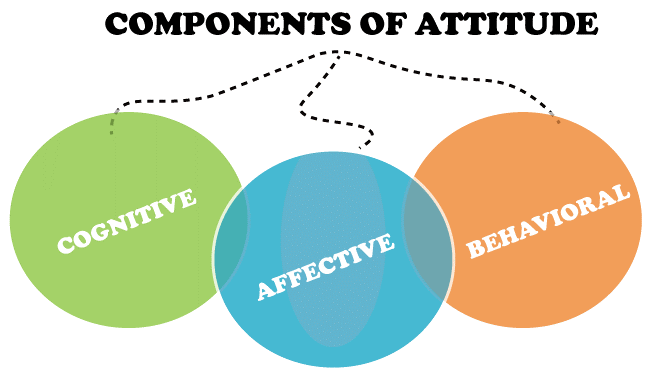
1. Cognitive ComponentConsumer attitude is cognitively based on beliefs. The value statement is connected to the cognitive component of attitude. It consists of principles, notions, and other knowledge a person may trust. Positive brand associations increase brand equity and may be attained via a variety of positioning techniques. Through brand associations, marketers create and create positive perceptions of a brand and negative perceptions of competitors. 2. Affective ComponentThe emotional element of consumer attitude is effective. An individual's sentiments towards another person, which may be good, neutral, or negative, are referred to as the affective component of attitude. Three study models describe the factors that influence emotional response.
3. Behavioral ComponentThe behavioral component of customer attitude is intention. The behavioral aspect of an attitude refers to how different circumstances or conditions affect people's behavior depending on their cognitive and emotional components. Two study models illustrate the link between actual purchases and consumption and consumer intentions: According to theories of reasoned action, consumers' actions are motivated by their intentions, their attitudes toward making purchases, and arbitrary standards. The principle of striving to consume explains real consumer behavior. It offers information on how long-term relationships with customers may be built and maintained. What are the Functions of Attitude?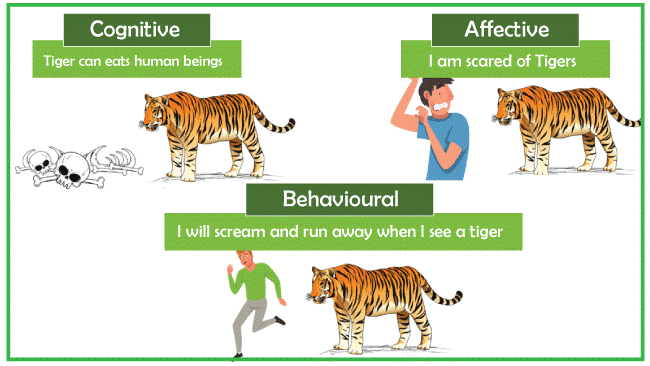
1. Knowledge FunctionThe knowledge function of attitudes helps people to comprehend their surroundings and to think and feel consistently. The majority of attitudes fulfil this fundamental purpose. 2. Utilitarian FunctionAn individual's attitude may assist them in maximizing advantages and minimizing drawbacks while engaging with other people, groups, and circumstances in their surroundings. Utilitarian attitudes lead to behavior that optimizes one's interests. 3. Performing a Social RoleAttitudes play a social role in people's ability to express themselves and engage in social contact. Adhering to a certain set of attitudes indicates one's affiliation with significant reference groups, which helps one express their basic beliefs and define their identity. This social role of attitudes, often referred to as the social identity function, drives a person's desire to forge his or her own unique social identity. 4. Maintain an Individual's Self-EsteemAttitudes can act as a healing technique for a person's internal mental conflict, which reflects tensions within the individual psyche. The defense mechanisms hide a person's genuine intentions from themselves or mentally distance him from groups he perceives as dangerous or hostile. Attitudes support self-esteem in several ways. An individual's perception of how many factors affect his own self-evaluation affects his attitudes toward a variety of things. Factors Behind the Formation of Attitudes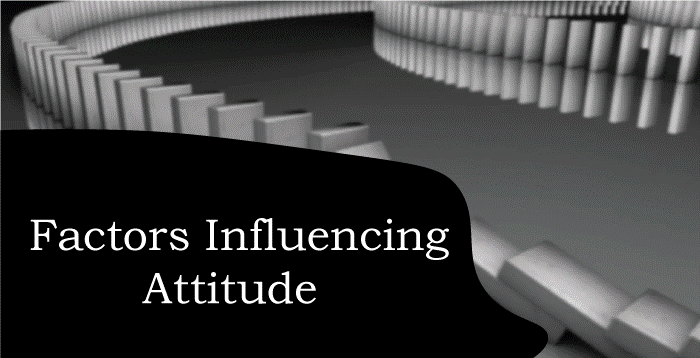
1. CultureCulture has a significant impact on a person. Culture includes religion, tradition, conventions, beliefs, rewards, and punishments. The process through which Culture moulds people's attitudes is known as socialization. Also, Culture teaches people what attitudes, behaviors, and beliefs are appropriate in their daily lives and society. For Example: - In India, eating beef is typically frowned upon, but there is no such prohibition in western nations. 2. FamilyA person's family is their closest and most significant social group. It is the birthplace of new attitudes. In the family system, parents have a greater impact on how a child develops their attitudes. Relationships within the extended family and between siblings are particularly significant in determining attitudes. 3. Social GroupsIn addition to family, a variety of social groups?including friends, peers, coworkers, etc. ?significantly influence the development of attitudes. Take into account India's voting behavior. There are those who don't read newspapers, watch debates, or pay attention to candidate remarks. In order to choose a candidate, they consult with friends, relatives, etc. A candidate's decision is most obviously influenced by families, friends, and other similar social groupings. 4. InstitutionsA person is never by himself. One or more institutions influence him from birth till his death. As an illustration, educational institutions like schools and universities serve as information reservoirs, moulding people's views and values and creating attitudes. 5. FamiliarityFamiliarity fosters a good outlook. Any familiarity may help a man feel at ease because men often have a fear of the unfamiliar. Familiarity and traditional conditioning have an impact on a person's emotions, which in turn shapes the emotional aspect of attitudes. What are the Techniques to Bring Change in Attitude?1. Classical/ Pavlovian ConditioninIn this method, the subject is repeatedly exposed to both positive and neutral stimuli over time, the reaction to neutral stimuli equals the response to positive stimuli. 2. Instrumental ConditioningA process wherein a positive conduct, when rewarded, is more likely to be repeated than a bad behavior, which, if repeated, would result in punishment and, thus, be less likely to be repeated. Example: Parents who encourage their kids to succeed by praising them in front of peers can help them develop a good attitude toward accomplishment. Furthermore, children are deterred from repeating their mistakes when parents discipline them. 3. Social ObservationLearning from our social surroundings, including family, school, the media, and its expression, is a part of this. Attitudes have a social role in an individual's ability to express themselves and engage in social contact. How does Attitude Influence Behavior?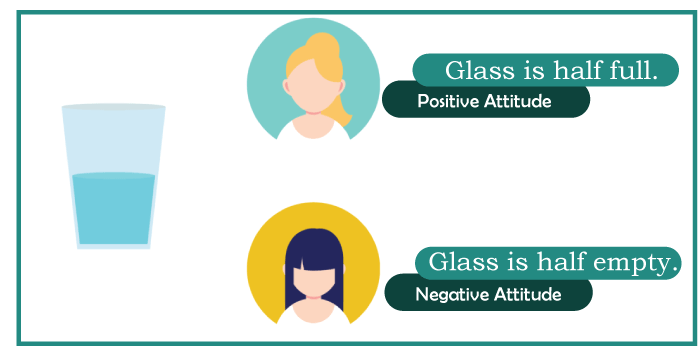
1. Positive AttitudeA person can favorably affect people around them if they have favorable attitudes regarding their job and coworkers (such as satisfaction, kindness, etc.). Example: Others with a positive outlook are energetic and productive, and they make an effort to uplift the morale of those around them. 2. Negative AttitudesA person who exhibits unfavorable attitudes (such as unhappiness, boredom, etc.) will act in that way. As an example, people with these attitudes regarding their work may also impact those around them and behave in a way that hinders efficiency and effectiveness. 3. Selfish AttitudeIt will influence a person's behavior in a self-centered way. Example: Making decisions based on what is best for oneself. 4. Logic or Rational AttitudesIt promotes rational behavior. Example: A sensible individual would never act in a superstitious manner and will always look for a reason for their actions. 5. Egoistic AttitudeIt will lead to a bad attitude and bad behavior. Illustration: Older people may dominate their younger siblings even though they are wrong in order to maintain their sense of superiority. 6. Attitude based on Values and BeliefsIt will behave in accordance with the values. As an illustration, in India, it is traditional to touch the feet of senior citizens out of respect. Formation of AttitudeAlthough attitudes are primarily learnt through time, some hereditary traits do influence such attitudes. The following list includes several learnt traits linked to the development of attitudes:
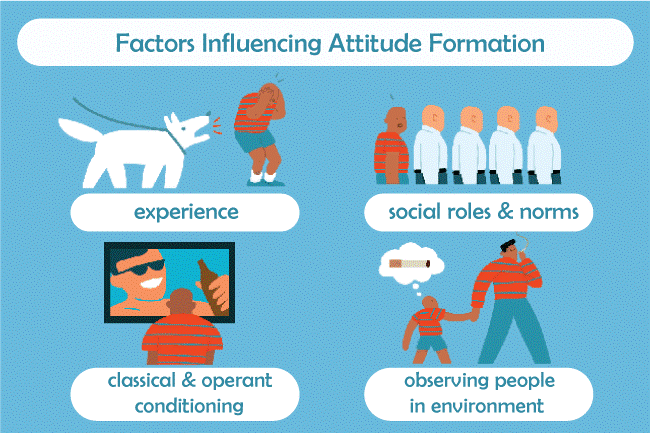
1. ExperiencesOur attitudes about certain individuals and circumstances are shaped by the experiences we have with them personally. People form views regarding things like working conditions, pay, supervision, group dynamics, and other topics as a result of their employment experiences. 2. Perceptual BiasesThe creation of our attitudes and behaviors is significantly influenced by perception, which is the consequence of the intricate interaction of several senses, including feelings, seeing, hearing, and so forth. For instance, if a manager thinks a subordinate has little skill, he will only offer him small amounts of responsibilities. Similarly, to this, we lose many terrific friends as a result of our altered perspective of them. 3. Observation of Other Person's AttitudeWhen we like someone, we try to adopt their attitude. For instance, we can strive to act similarly when we are inspired by someone else's ability to remain composed in the face of pressure. 4. AssociationOur mindset is greatly influenced by the group to which we belong. Our tight ties to a group would drive us to adopt the same mindset as the group. 5. PersonalityThe impression that a person creates on other people is a consequence of their attitude. It is formed by their personality, which is a collection of traits, habits, and conditioned responses to certain stimuli. Types of AttitudesIn terms of organizational behavior, there are primarily three types of attitudes:
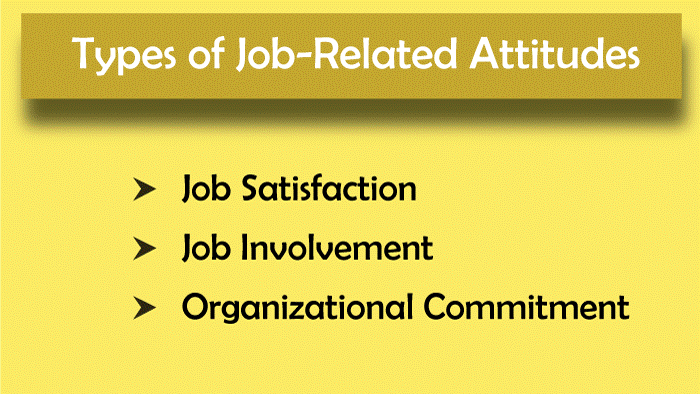
1. Job SatisfactionA range of thoughts and emotions that a person has about their profession, both favorable and bad. If someone is content, they will have a positive outlook on life, whereas those who are not satisfied would often have a pessimistic outlook. As a result of their interdependence in organizational behavior, attitude and work satisfaction are typically discussed together. 2. Employer InvolvementJob Involvement is the extent to which a person actively engages in, psychologically identifies with, and values his or her perceived level of performance in relation to self-worth. A person who is more satisfied with his job is less likely to be absent from work and to leave his employment, which shows that he values it. 3. Organizational DedicationA worker's level of identification with the organization's objectives and desire to remain a member is referred to as organizational commitment. Compared to work satisfaction, organizational commitment can be predicted by employment resignation or absence rates. Organizational commitment is influenced by employment autonomy, independence, and enrichment factors. ConclusionIt is obvious that attitude plays a role in our thoughts and behavior. Our attitudes are shaped by our experiences, beliefs and values. It is important to be aware of our attitudes because they can influence our actions and reactions. As a matter of fact, Attitude is like a magnet. A good attitude attracts all positive things into your life and a bad attitude attracts all negative things into your life. You decide what you want and can change accordingly.
Next TopicBiology Definition
|
 For Videos Join Our Youtube Channel: Join Now
For Videos Join Our Youtube Channel: Join Now
Feedback
- Send your Feedback to [email protected]
Help Others, Please Share










